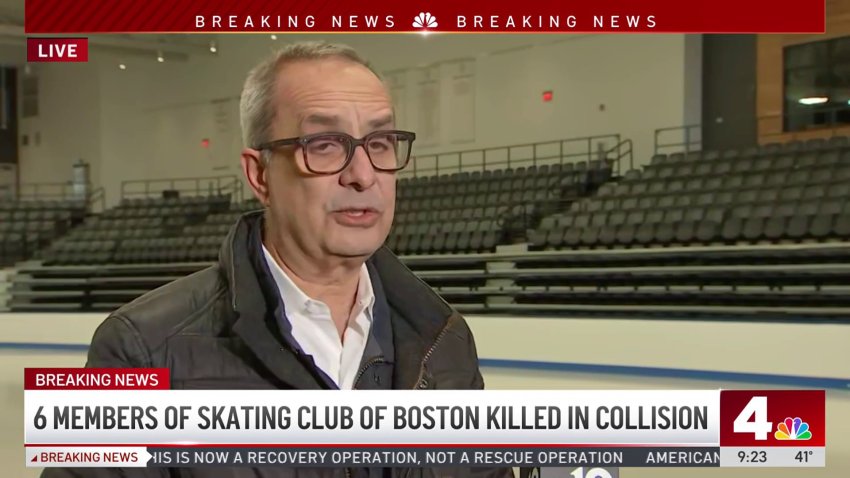The National Transportation Safety Board has begun an investigation into the deadly mid-air collision between an American Eagle regional jet and a military helicopter that left all 67 people onboard the aircrafts dead. NBC Chicago’s Natalie Martinez reports.
Live updates on the crash can be found here.
The National Transportation Safety Board has begun an investigation into the deadly mid-air collision between an American Eagle regional jet and a military helicopter that left all 67 people onboard the aircrafts dead.
Just under 24 hours after the crash occurred, the jet's two black boxes were recovered as an extensive search for evidence and details into what led up to the deadly collision get underway.
The collision occurred Wednesday evening in one of the world's most tightly controlled airspaces, just over 3 miles south of the White House and the U.S. Capitol. A massive search-and-rescue effort launched overnight turned into a recovery operation by mid-Thursday morning.

What happened in the crash?
The collision involved a regional jet out of Wichita, Kansas, that was preparing to land and a military helicopter that was on a training exercise, according to the Federal Aviation Administration.
A few minutes before the jet was to land, air traffic controllers asked American Airlines Flight 5342 if it could do so on a shorter runway, and the pilots agreed. Controllers cleared the jet to land and flight tracking sites showed the plane adjust its approach to the new runway.
Less than 30 seconds before the collision, an air traffic controller asked a helicopter if it had the arriving plane in sight. The controller made another radio call to the helicopter moments later, saying “PAT 25 pass behind the CRJ" — apparently telling the copter to wait for the Bombardier CRJ-701 twin-engine jet to pass. There was no reply. Seconds after that, the aircraft collided.
The plane’s radio transponder stopped transmitting about 2,400 feet short of the runway, roughly over the middle of the Potomac.
Feeling out of the loop? We'll catch you up on the Chicago news you need to know. Sign up for the weekly Chicago Catch-Up newsletter.
The body of the plane was found upside-down in three sections in waist-deep water, officials said. The helicopter's wreckage was also found.
What did video show?
A grainy snippet of video footage taken in the dark of night, seemingly by an airport CCTV camera, appears to show the fatal mid-air collision.
In the first moments of the video footage, nothing seems untoward. It shows scenes one would expect from any bustling airport — including another passenger aircraft taxiing in the foreground.
A bright light flashing cherry red atop that plane's fuselage as it maneuvered carefully past a retractable gangway was the only dash of color in the otherwise largely monochrome picture — before the angry fireball that subsequently punctures the night sky.

In the video's next second: the unexpected. A flickering dot of light appears from the left of the frame, at first so faint that it might be mistaken for a distant star.
But it is moving. Quickly, too. The dot appears to be the Army UH-60 Blackhawk helicopter, on a training exercise with a crew of three soldiers aboard.
The tiny smudge of light from the helicopter speeds ever-closer to the AA flight, but then flickers off and disappears for a tiny fraction of a second. Has it sensed danger and veered off the collision course?
The next moment brings the fateful answer: Unfortunately, no.
The helicopter light-dot reappears, still racing toward the larger bright white of the passenger plane.
Then, an explosion — a spreading fireball of yellow and orange that suddenly flares in the darkness like an unnatural sun before starting to fade.
Where, just milliseconds earlier, there had been only two moving lights in the sky — the plane's and the helicopter's — now there are many: debris scattering and tumbling through the darkness.
In the foreground, the other untouched passenger plane still trundles on, seemingly unaware as what appears to be the largest chunk of wreckage is falling fast and uncontrolled behind it.
The aircraft plummeted into the Potomac River, where the fuselage was found upside down in three sections in waist-deep water, officials said.
Who was on the plane?
The collision was the deadliest U.S. air crash in nearly 24 years. At least 28 bodies have been pulled from the icy waters.
Among the passengers were members of the Skating Club of Boston who were returning from the 2025 U.S. Figure Skating Championships in Wichita. They included teenage figure skaters Jinna Han and Spencer Lane, the teens' mothers and two highly regarded Russian-born coaches, Evgenia Shishkova and Vadim Naumov, who won a 1994 world championship in pairs skating.
Other Russians were also on the jet, according to the Kremlin.

Skating Club of Boston CEO Doug Zeghibe said Thursday that a total of 14 of the crash victims were coming back from a national development camp for promising young skaters following the U.S. Championships.
The three soldiers aboard the helicopter were doing an annual night proficiency training flight, Defense Secretary Pete Hegseth said.
The crew was “very experienced” and were not new to the unit or the congested flying that occurs daily around Washington, D.C. That is according to Jonathan Koziol, chief of staff for Army aviation.
“Both pilots had flown this specific route before, at night. This wasn’t something new to either one of them,” Koziol said. “Even the crew chief in the back has been in the unit for a very long time, very familiar with the area, very familiar with the routing structure.”
The crew included an instructor pilot and pilot in command were experienced to the point where either crew member “could manage that helicopter by themselves.”
Their names had not been released as officials were notifying relatives. Their bodies were were among those recovered, according to U.S. officials who spoke on the condition of anonymity to discuss details that hadn't been announced yet.
What do we know about the investigation?
NTSB holds first briefing
National Transportation Safety Board Chair Jennifer Homendy said Thursday at a press conference that “we look at facts on our investigation and that will take some time.”
She was responding to a question on speculation about the cause of the crash.
Homendy also said the black boxes from the aircraft have not been recovered yet.
Attorney says airport's crowded space is well-known fact
The crowded airspace around the airport was well known before the crash, said Robert Clifford, an aviation attorney from Chicago involved in numerous airline disaster cases.
“I can’t get over how stunningly clear it is that this was a preventable crash and this should never, ever have occurred,” Clifford told The Associated Press.
“There have been discussions for some time about the congestion associated with that and the potential for disaster. And we saw it come home last night,” Clifford said.
He said the Ronald Reagan Washington National Airport was “very unique" as it is not only located near the nation's capital but also is a highly restricted space.
“However, because of the massive military presence in our capital, the Pentagon and a number of bases, there’s understandably a lot of military aircraft in the area.”
Report says staffing in control tower was 'not normal' at time of deadly air collision
A report by the Federal Aviation Administration says staffing in the air traffic control tower was “not normal” at time of the midair collision near Washington. However, a person familiar with the matter told the Associated Press that staffing was at a normal level, as positions are combined when workers take breaks.
The report was obtained Thursday by The Associated Press.

